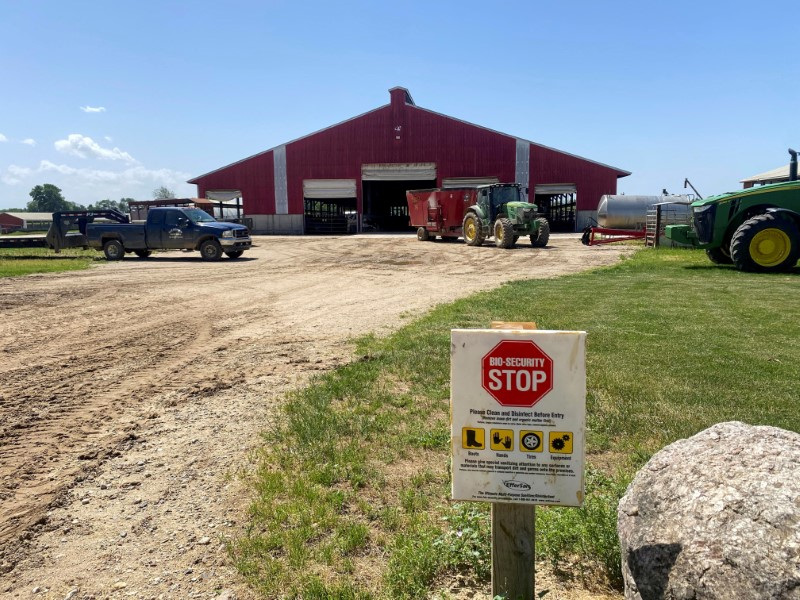By Leah Douglas and Tom Polansek
WASHINGTON/CHICAGO (Reuters) – The U.S. bird flu outbreak among dairy cattle is much bigger than official figures suggest, due to farmers’ reluctance to test their animals and risk the economic fallout of a positive result, according to Reuters interviews with dairy experts. veterinarians and farmers in six states with known cases.
The U.S. Department of Agriculture has counted bird flu in about 190 dairy herds in 13 states since March. The virus’s jump from birds to cows raised concerns that it could adapt to spread among humans. Scientists have warned that limited surveillance could weaken the US’s ability to respond to further human spread.
Thirteen dairy and poultry farm workers have been infected with bird flu this year, according to the Centers for Disease Control and Prevention.
Reuters spoke to more than a dozen researchers, veterinarians, farmers and livestock groups to understand whether the spread of bird flu among dairy cattle is being closely monitored.
State animal and human health experts in three states who work closely with veterinarians and farmers said the government figure is likely an undercount because farmers fear the economic hardship a positive test will bring, including not being allowed to sell their milk or livestock for weeks.
The virus reduces milk production in cattle. The US, the world’s second largest cheese producer after the European Union, is the only country with known infections in cows.
“While we have nine official positive results, there are many more farms that are affected or infected and are simply not testing,” said Joe Armstrong, a veterinarian and livestock expert at the University of Minnesota who works with farmers around the world has spoken. the state.
A more accurate number of livestock cases for Minnesota would be three to five times higher, Armstrong said.
A USDA spokesperson said the agency has encouraged testing by requiring negative tests for cows transported across state lines since April and offering a voluntary program for weekly testing of farmers’ milk supplies. Twenty-four dairy herds are participating in that program, out of about 24,000 farms nationwide that sell milk, according to agency data.
Six farmers, veterinarians and other experts said farmers were reluctant to test because they did not believe the virus was a serious problem or because government incentives for testing could not offset their expected losses.
78-year-old Colorado farmer Terry Dye said his two dairies were contaminated this summer and that he did not notify the state because he wanted to handle the matter privately. State agriculture officials eventually learned of the infections and quarantined his animals, he said.
“Sometimes it’s more convenient not to know,” Dye said.
USDA offers to compensate farmers with infected animals for veterinary care and 90% of lost milk production. Forty-seven herds have signed up for financial support from the agency, although that total includes farms without infections seeking support for biosecurity costs.
USDA tests raw milk from cows to identify the virus in herds. The Food and Drug Administration has tested commercial milk supplies separately and says pasteurization kills the virus, making milk safe to drink.
HARDER TESTING
Experts say ways to better track the spread include more states mandating raw milk testing or giving farmers higher compensation.
Michigan and Colorado have taken an aggressive approach to containing bird flu in livestock, although experts there still believe cases are being missed.
Phil Durst, a lecturer at Michigan State University who has spoken to farmers whose herds have contracted the virus, said the 27 positive herds in Michigan are likely an undercount of at least a third.
Jenna Guthmiller, an assistant professor of immunology at the University of Colorado who has studied the virus, said Colorado’s 63 positive herds are also likely a subsample.
After a series of outbreaks, on July 22, Colorado became the only state to require dairy farms to test bulk milk supplies weekly. The tests revealed ten infected herds that have been quarantined.
“Once we better understand the scope and scale of the outbreak, we can take action to prevent further spread,” said Colorado State Veterinarian Maggie Baldwin.
Some farmers are not testing because they distrust government officials or information about the risks of bird flu to livestock and people, four sources said.
“There are plenty of dairy farms I’ve heard about, but I just don’t believe it,” said Jason Schmidt, a dairy farmer in eastern Kansas.
In Oklahoma, a dairy that suspected contamination in April only submitted stored milk samples to the USDA for testing in July, according to the state. The herd had recovered by the time testing confirmed an outbreak, and Oklahoma has had no other reported cases, the state said.
In states with few or no infected cows, farmers and veterinarians are concerned that when the virus arrives or reemerges, they won’t be able to track it.
“The old adage is that fever is not cured by measuring the temperature. So if we don’t test, we’re not positive,” said Mark Hardesty, a dairy veterinarian in Ohio who reported on a dairy farm. herd infection in April.

Wisconsin, the second largest milk-producing and largest cheese-producing state, has reported no cases of bird flu in cattle. Dairy farmers probably wouldn’t test even if they suspected symptoms in their herd, said Keith Poulsen, director of the Wisconsin Veterinary Diagnostic Laboratory.
“It’s still cheaper to just weather a herd outbreak, recover and move on,” Poulsen said.


